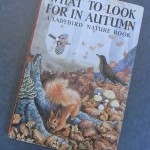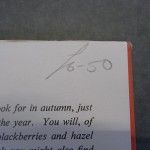This copy of the Autumn volume was acquired by an academic interested in the study of children’s literature. This also just happens to be an academic who has kindly contributed ideas and content towards the main banners in the exhibition itself. Dr Sue Walsh is a colleague of my co-curator Neil Cocks and works alongside him within CIRCL (Centre for International Research in Childhood: Literature, Culture and Media). With this institutional affiliation in mind it it easy to see why she might have been interested in acquiring a copy of this particular book.

Sue Walsh’s copy of ‘What to Look For in Autumn’, complete with the standard dust jacket. It appears much the same as all the other first editions on display.
It appears at first glance to be much like the other first editions that we have borrowed for the exhibition. It has its dust jacket and is in near pristine condition. The price is, of course, the standard 2’6 for which Ladybird became known.
However, as with other individual copies, more careful visual inspection reveals subtle differences in the way this particular book has been treated by its previous owners. There are scribbles that evidence a perhaps less caring owner, most likely a child!

Scribbles on the title page of Sue Walsh’s copy of the ‘Autumn’ book, surrounding the iconic Ladybird logo.
Perhaps more interesting still is the later addition of an alternate price, no doubt by an enthusiastic second hand book seller. The price of £6.50 has been written inside, indicating a significant increase on its original price of 2/6. Whatever Sue herself paid for the book, this is evidence enough that the financial value of these volumes has increased markedly and that they are nolonger the economical literature of the people that they once were. Instead, they are the preserve of book collectors, enthusiasts, and specialists.
Sue herself acquired her copy with the possibility of using it for teaching or research purposes at some point in the future. I hope that involvement in this project has enthused her to make active use of this copy in the classroom context. Thanks to Sue for the generous loan of this volume and thanks also for providing ideas and content for the following exhibition banner.






